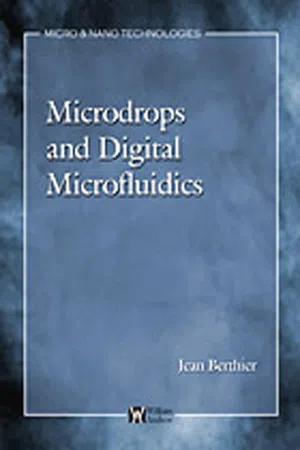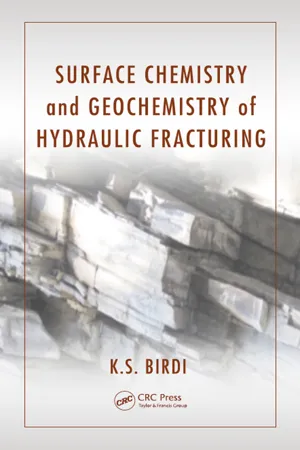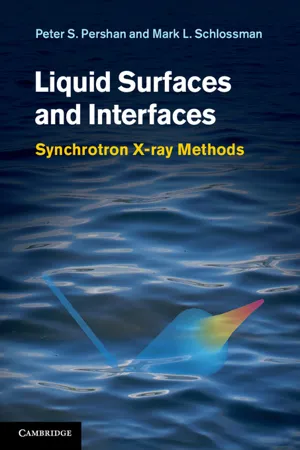Technology & Engineering
Capillarity
Capillarity refers to the ability of a liquid to flow in narrow spaces without the assistance of external forces, such as gravity. This phenomenon is due to the cohesive and adhesive properties of the liquid, which allow it to climb or descend through small openings, such as tubes or porous materials. Capillarity plays a significant role in various engineering applications, including fluid dynamics and material science.
Written by Perlego with AI-assistance
Related key terms
1 of 5
9 Key excerpts on "Capillarity"
- Rachid Ababou(Author)
- 2018(Publication Date)
- Wiley-ISTE(Publisher)
Another example of the manifestation of capillary forces is seen in the liquid water jet from a water tap (which anyone can observe by opening a water tap progressively). Indeed, at low flow rate, the jet may oscillate and break up into small droplets at some distance from the tap. In short, the reason for droplet formation is that the jet becomes unstable along the way downstream. Capillary forces are responsible for this instability.Other capillary phenomenaApart from geosciences, hydrology and the natural sciences, there are many industrial applications of Capillarity effects. Let us cite just a few:- – industrial absorbing materials (including, for instance, toilet paper);
- – textiles (see the previously discussed example of the Mackintosh raincoat);
- – printing industry and ink absorption on paper (a fibrous porous material);
- – liquid composite molding (Pillai 2002, 2004);
- – spacecraft propellant management device based on Capillarity (transfer of liquid fuel by Capillarity in low gravity environments);
- – heat pipes and capillary pumps (devices used in the industry and in space-crafts), etc.
Heat pipesLet us briefly consider the case of heat pipes:In a heat pipe, Capillarity is used to transfer a liquid from the cold end to the hot end through a porous wick (gravity could be used instead, but the capillary wick “trick” becomes very useful in low gravity environments). There is reverse, non-capillary flow of vapor and heat inside the heat pipe, from the hot end (vaporization) to the cold end (condensation). It can take place in a cavity located inside the wick.For completeness, note that capillary-driven heat pipes are used in a number of industrial applications. Several of these applications are presented and reviewed on the Wikipedia (2013) page on heat pipes (http://en.wikipedia.org/wiki/Heat_pipe- Suman Chakraborty(Author)
- 2012(Publication Date)
- CRC Press(Publisher)
Wicking is another form of Capillarity, where the fluid is transported through the pores. Common examples of wicking are the soaking or absorbing of flu-ids on paper towels and lighting of oil lamps/candles. Capillary flows are exploited in thin layer chromatography, where dissolved solutes are trans-ported with the solvent at various speeds. Different solutes get separated from the solvent mixtures depending upon their affinity for the solvent or the absorbent coating. Capillary filling may be aided through several external driving forces, although it is primarily a surface tension–driven flow, wherein the actua-tion and control of fluid transport through a manipulation of the surface tension forces. The manipulation may be hydrodynamic, thermal, chemi-cal, electrical, or optical in nature. Since surface tension forces scale with the linear dimensions, these become progressively more dominant with reduction of system length scale from macro to micro and further to nano. In a liquid-gas system, for example, molecules in the bulk of the liquid are pulled equally in all directions by the neighboring liquid molecules, result-ing in no net force. At the interface, however, the molecules experience a net attractive force from other molecules inside the liquid, since these are not attracted as intensely by the molecules in the gaseous phase located on the other side. This is due to a denser molecular packing in the liquid phase than in the gas phase and a consequently stronger intermolecular force of attraction offered by the liquid molecules. To maintain interfacial equilibrium, molecules at the interface rearrange themselves to diminish the surface area (in order to minimize the surface energy), and a menis-cus is developed in the form of a surface resembling a stretched elastic membrane. The pressure difference on either side of the meniscus leads to development of net normal force (pressure difference times the pro-jected surface area).- eBook - ePub
- Jean Berthier(Author)
- 2008(Publication Date)
- William Andrew(Publisher)
2Theory of Wetting2.1 Introduction
The understanding, development, and design of fluidic microsystems require dealing with forces that are usually overlooked and neglected at the macroscopic scale. In the case of digital microfluidics, interfaces are omnipresent and capillary and surface tension forces have a tremendous influence. These forces are of utmost importance at the microscopic level, whereas at a macroscopic scale, they are usually neglected in front of forces like pressure or gravity. Typical ranges of pressure in macroscopic applications are 1–100 bars, i.e., 105 to 107 Pa, whereas pressure levels seldom reaches 0.1 bar (104 Pa) above atmospheric pressure in microfluidic systems. Most of the time gravity has no or little consequence in the design of fluidic microdevices.Numerous examples of the importance of Capillarity can be found in existing microsystems for biotechnology, or microchemistry, and in space applications. In order to point out the importance of capillary forces we give in Figs. 2.1 –2.4 some examples illustrating the importance of capillary forces in microsystems.Figure 2.1 (a) View of a microplate for Biotechnology applications, from [1 ]. (b) Capillarity is a determining force when spotting a droplet on a microplate, from [2 ]. © 2004 JALA. Reprinted with permission. JALAFigure 2.2 Schematic view of a digital microfluidic system based on electrowetting.Courtesy Rain Dance Technology Inc. [3 ].Figure 2.3 (a) Successive use of T-junctions with wetting and non-wetting walls results in the encapsulation of two liquids in a droplet [5 ]; (b) clever use of T-junctions can be used to obtain simultaneous encapsulation; reprinted with permission from [5 ]. © 2004 American Chemical Society. American Chemical SocietyFigure 2.4 Droplets in a glass capillary: crystals of proteins were grown under microbatch condition in these droplets, from [6 ]. © 2004 Wiley, reprinted with permission. Wiley - K. S. Birdi(Author)
- 2016(Publication Date)
- CRC Press(Publisher)
Let us consider aspects in the field of wettability. Surely, everybody has noticed that water tends to rise near the walls of a glass container. This happens because the molecules of this liquid have a strong tendency to adhere to the glass. Liquids that wet the walls make concave surfaces (e.g., water/glass); those that do not wet them make convex surfaces (e.g., mercury/glass). Inside tubes with an internal diameter smaller than 2 mm, called capillary tubes, a wettable liquid forms a concave meniscus in its upper surface and tends to go up along the tube. In contrast, a nonwettable liquid forms a convex meniscus, and its level tends to go down. The amount of liquid attracted by the capillary rises till the forces that attract it balance the weight of the fluid column. The rising or lowering of the level of the liquids into thin tubes is named Capillarity (capillary force). One notices that a liquid inside a large beaker is almost flat at the surface. However, the same liquid inside a fine tube will be found to be curved (Figure 2.5). The rise in height is found to be dependent on the radius of curvature. The capillary rise is higher in the narrow tube. This behavior is very important in everyday life. For example, in the case of oil or gas recovery, the most important characteristic is the pore size of the reservoir rock (which determines the capillary force). The physical nature of this phenomenon will be the subject of this section. The mechanical equilibrium at liquid surfaces has been investigated for over a century. The liquid surface has been considered as a hypothetical stretched membrane, this membrane being termed the surface tension (Adamson and Gast, 1997; Chattoraj and Birdi, 1984; Birdi, 1989, 2003a, 2003b, 2016; Shou et al., 2014)- eBook - PDF
Surface and Colloid Chemistry
Principles and Applications
- K. S. Birdi(Author)
- 2009(Publication Date)
- CRC Press(Publisher)
9 2 Capillarity and Surface Forces (Liquids) 2.1 In t r o d u c t Io n It is common observation that a liquid takes the shape of a container that surrounds or contains it. However, it is also found that, in many cases, there are other subtle prop-erties that arise at the interface of liquids. The most common behavior is bubble and foam formation. Another phenomena is that, when a glass capillary tube is dipped in water, the fluid rises to a given height. It is observed that the narrower the tube, the higher the water rises. The role of liquids and liquid surfaces is important in many everyday natural processes (e.g., oceans, lakes, rivers, raindrops, etc.). Therefore, in these systems, one will expect the surface forces to be important, considering that the oceans cover some 75% of the surface of the earth. Accordingly, there is a need to study surface tension and its effect on surface phenomena in these different systems. This means that the structures of molecules in the bulk phase need to be considered in comparison to those at the surface. The surface molecules are under a different force field from the molecules in the bulk phase or the gas phase. These forces are called surface forces . A liquid surface behaves like a stretched elastic membrane in that it tends to contract. This action arises from the observation that, when one empties a beaker with a liquid, the liquid breaks up into spherical drops. This phenomenon indicates that drops are being created under some forces that must be present at the surface of the newly formed interface. These surface forces become even more important when a liquid is in contact with a solid (such as ground–water; oil reservoir). The flow of liquid (e.g., water or oil) through small pores underground is mainly governed by capillary forces . Capillary forces are found to play a very dominant role in many systems, which will be described later. - eBook - PDF
- J.J. Bikerman(Author)
- 2012(Publication Date)
- Academic Press(Publisher)
CHAPTER I Mechanics of Liquid Surfaces. Capillarity MOLECULAR FORCES A N D CAPILLARY PRESSURE §1. In contrast to the behavior of solids, liquids rise or are depressed in capillary tubes. Solids break down to fragments which have no one definite shape while liquids form smooth drops. Two pebbles pressed together do not, and two drops in contact do, coalesce. These effects and a host of similar observations were accounted for (Gessner, 1751) as consequences of surface tension: liquid surfaces have a tendency to contract and to assume the smallest area possible under the circumstances. Laplace 1 proved that surface tension is not an independent property. Its existence is a direct consequence of the facts that (a) intermolecular forces have a short range of action and (b) the concentration of matter in the gas phase, as a rule, is very much smaller than in the liquid. This concept is con-veniently explained using the more modern notion of energy. In Fig. 1, the two small circles represent spheres of molecular action, that is, spheres in which the forces originating in the central atom or molecule of the sphere still have a significant value. The line M M indicates the boundary between the liquid (below) and its vapor (above). Because of symmetry, there is no resultant force on the particle (A) deep in the liquid but the particle (B) in the surface is attracted by the dense liquid more strongly than by the (rare) vapor. Hence, work must be performed to raise the particle into the boundary. When the surface area is extended, more molecules or atoms are raised, and the work done against the molecular forces during this process is what macroscopically appears to us as the work to overcome surface tension. The free energy re-siding in the extended surface is the work spent on moving particles from the bulk to the interface. 1 2 Τ. MECHANICS OF LIQUID SURFACES. Capillarity FIG. 1. Spheres of molecular action in the bulk (A) and in the surface (B). - F Dullien(Author)
- 2012(Publication Date)
- Academic Press(Publisher)
L Capillarity in Porous Media In a capillary system the surfaces separating the various bulk phases play a significant part in determining the physical-chemical state of the system. According to this definition, the vast majority of porous media are capillary systems. In the case of capillary systems, mechanical equilibrium, i.e., the absence of a net mechanical force acting on the system, is determined not only by the hydrostatic pressure and gravitational attraction but also by forces associated with surface tension. In this chapter the discussion is limited to the study of systems in mechani-cal equilibrium in which the temperature is uniform. They need not, however, be in a state of thermodynamic equilibrium. For example, porous media systems containing an irreducible wetting phase or a residual nonwet-ting phase saturation are not, in general, in a state of thermodynamic equilibrium. The question of thermodynamic equilibrium is discussed in greater detail in Sections 2.3 and 2.4. First, the conditions for mechanical equilibrium are studied, and this leads to the definition of capillary pressure. Subsequently, this important parameter is applied to the characterization of the state of porous media containing two or more fluids. Then, the thermodynamics of quasi-static displacement of a fluid by another immiscible fluid is reviewed. The subject of modeling capillary pressure curves with the help of models of pore struc-ture is discussed next. Finally adsorption in porous media is reviewed briefly. 5 6 2. Capillarity in Porous Media 2.1 SURFACE BETWEEN TWO FLUIDS When two fluids, for example, a liquid and a gas, are in contact with each other, they are in general separated by a thin layer called the interface, interphase, or surface phase. From a mechanical standpoint, the system behaves as if it consisted of two homogeneous fluids separated by a uniformly stretched membrane of infinitesimal thickness.- eBook - PDF
Porous Media
Fluid Transport and Pore Structure
- F. A.L. Dullien, Howard Brenner(Authors)
- 2012(Publication Date)
- Academic Press(Publisher)
2 Capillarity in Porous Media In a capillary system the surfaces separating the various bulk phases play a significant part in determining the physical-chemical state of the system. According to this definition, the vast majority of porous media are capillary systems. In the case of capillary systems, mechanical equilibrium (i.e., the absence of a net mechanical force acting on the system) is determined not only by the hydrostatic pressure and gravitational attraction but also by forces associated with surface tension. In this chapter, unless stated otherwise, the discussion is limited to the study of systems in mechanical equilibrium in which the temperature is uniform. They need not, however, be in a state of thermodynamic equilib-rium. For example, porous media systems containing residual wetting phase or nonwetting saturations are not, in general, in a state of thermody-namic equilibrium. The question of thermodynamic equilibrium is discussed in greater detail in Sections 2.3 and 2.4. First, the conditions for mechanical equilibrium are studied, and this leads to the definition of capillary pressure. Subsequently, this important parame-ter is applied to the characterization of the state of porous media containing two or more fluids. Then, the thermodynamics of quasi-static displacement of a fluid by another immiscible fluid is reviewed. The subject of modeling capillary pressure curves with the help of models of pore structure is discussed next. 117 118 2. Capillarity in Porous Media 2.1. SURFACE BETWEEN TWO FLUIDS When two fluids, for example, a liquid and a gas, are in contact with each other, they are in general separated by a thin layer called the interface, interphase, or surface phase. From a mechanical standpoint, the system behaves as if it consisted of two homogeneous fluids separated by a uniformly stretched membrane of infinitesimal thickness. - eBook - PDF
Liquid Surfaces and Interfaces
Synchrotron X-ray Methods
- Peter S. Pershan, Mark Schlossman(Authors)
- 2012(Publication Date)
- Cambridge University Press(Publisher)
1 Introduction The physical properties of liquid surfaces have been an area of scientific interest for the past two centuries and more. In the early nineteenth century the study of Capillarity, as exemplified by the study of the rise of liquids either in a small-bore capillary tube or between glass plates, proved important in the pursuit of a general scientific understand- ing of particle interactions that could not be explained by Newton’s theory of gravity (Rowlinson, 2002). In the early development of the mathematical theory of Capillarity, in particular by Laplace, it was assumed that the surface of a liquid was without structure and could be treated as an abrupt boundary between liquid and vapor (Laplace, 1807). Although Poisson objected to the assumption of an abrupt interface on fundamental grounds, it was not until the late nineteenth century that van der Waals developed a theory of surface tension that relied upon a diffuse interface (van der Waals, 1893, van der Waals, 1979). This statistical-mechanical theory proved important for the general understanding of non-uniform systems. Also in the late nineteenth century Pockels and Lord Rayleigh noted that measurements of the surface tension of a film of olive oil on water allowed them to deduce that its thickness was about 1 nm, thus setting the size of a molecule of olive oil and enabling deductions of the spatial extent of intermolecu- lar forces of attraction between water and oil (Pockels, 1891, Pockels, 1892, Rayleigh, 1899). Further experiments on molecular films by Langmuir (Langmuir, 1917) allowed observations on the size and shapes of molecules, long before the modern investigative methods of the later twentieth century confirmed them. Advances in our understanding of all aspects of condensed matter during the twentieth century have taken advantage of contributions over a broad front of parallel research.
Index pages curate the most relevant extracts from our library of academic textbooks. They’ve been created using an in-house natural language model (NLM), each adding context and meaning to key research topics.








